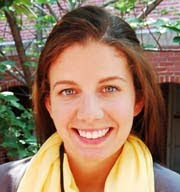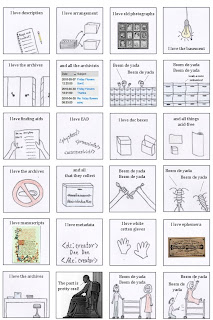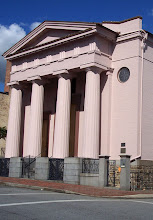A blog post by Lindsay Waskow.

Due to the fact that the SuperKids camp focuses very much on enriching the reading skills of the many Baltimore City Public School students involved, we have come up with activities that help them practice this skill. By creating scavenger hunts and activity books that relate to the synagogues and exhibits here, we are not only encouraging them to read, but are also helping them learn about new aspects of Judaism, while making sure that they are having fun at the same time.
This year the SuperKids camp began coming to the museum on Tuesday June 29th, and have continued to come with a new group of kids every Tuesday. It is a six week program, and will therefore end on this coming Tuesday, August 3rd. Since there is a new group of children every Tuesday, the activities we have created remain the same from week to week. Every week there are new counselors that come with the children and assist in leading them through the different activities. There are also three general counselors, Bridgette, Eric, and Matt, that come every week to help supervise the children’s visit and assist in helping the kids through the activities in any way they can.

Throughout the hour and a half to two hours that they are here, the children are broken into two or three groups, depending on the number of children that are there are that week, and rotate through three different activities. One of the activities includes a trip to Lloyd Street synagogue, where the children are introduced to what a synagogue is and learn briefly about the history of this particular synagogue. In order to help them understand the different parts of the synagogue, Julia and I created a “Lloyd Street Scavenger Hunt”. On this worksheet, we guide the children and help them find different objects in the synagogue such as the Ark, a specific pattern on the wall, a Menorah, the Eternal Light, a Star of David, the columns, and the stained glass windows.
While some of the directions only aid the children to find the specific object, there are also questions that ask them to count how many of a certain object they can find. In addition to the different questions we ask, we also provide them with a black and white picture of the object to further assist them in finding them. Although I have never supervised the Lloyd Street synagogue activity, I have heard from Lois and Elena, who have taken turns supervising it, that it continues to be a success as it not only helps the children learn about the different parts of the synagogue, but also encourages much discussion among them. This is particularly true with our new idea to laminate the scavenger hunt, which eliminates the need for the children to write their answers down with pencil, and instead promotes more conversation and discussion.
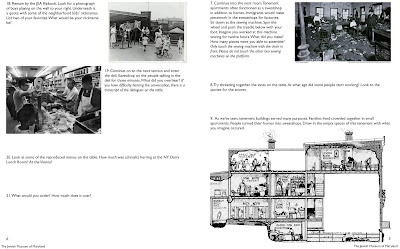
A second activity in which the Superkids participate is a scavenger hunt of the “Voices of Lombard Street” exhibit. Julia and I usually lead at least one of the broken up groups through the exhibition with the help of a scavenger hunt. Before the group enters the exhibit, we usually give them an introduction and let them know the kinds of things they are going to see as well as hear. We also ask them and make sure they know what the terms “immigrant” and “synagogue” mean, as these words are important in understanding the exhibit.
After this introduction, we then ask the children to find a partner, and each pair gets a clipboard with a scavenger hunt attached to it as well as a pencil. Each pair usually goes around the exhibit with a counselor to help them, or if there are not enough counselors, then sometimes we have a counselor take two or more pairs through the exhibit. Either way, the counselor makes sure the two children take turns reading and writing down the answers to the questions. Since the children who come are usually going into 1st, 2nd, or 3rd grade, the questions are fairly simple, but do allow the children to practice their reading skills. While some of the scavenger hunt asks direct questions that the children can answer by reading the panels in the exhibit, some questions allow the children to be more creative. For example, when they enter the house, the children are asked to play with the cooking utensils on the table and then have to write down what they pretended to make. They also get to draw their own interpretation of the gefilte fish in the bathtub after seeing the bathtub and reading the panels above it that have to do with this story.
One of the other aspects that the SuperKids like in the exhibit is going into Attman’s, playing with the pretend food, and then writing down what they pretended to order. In my opinion, the scavenger hunt seems to be the perfect length for these children and does a good job at highlighting what life was like one hundred years ago on Lombard Street.

The final activity that the SuperKids partake in is “The Golden Land” station. Julia and I usually lead this section for all of the groups and in my opinion, it seems to be the most fun of the stations for the children. After asking them about their visit to the “Voices of Lombard Street” exhibition and reviewing the terms “immigrant” and “synagogue”, we introduce the station and tell them that they will have a chance to act out what they saw in the exhibit. Julia and I then break the group into three smaller groups to go to three separate activities within the room.
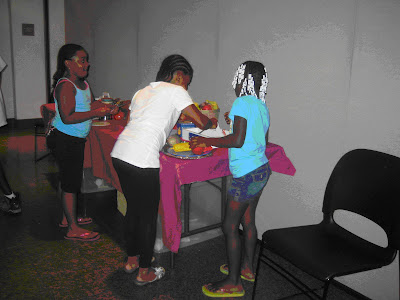 Making a pretend "Shabbat dinner."
Making a pretend "Shabbat dinner."Before letting them go to their first station, we explain all of the stations in general. We usually talk about the pretend food on the back table first and explain what a Shabbat dinner is to them and encourage them to make their own. We then address the box of clothes, shoes, and vests on the floor and invite the children to dress up like people dressed one hundred years ago. Finally, we explain to the children that they will all be getting an activity book about “The Golden Land” that they will be able to color.
 Dressing up!
Dressing up!We then send them to their first stations, and after about ten minutes send them to their next stations, and ten minutes later send them to their final stations. Throughout these three rotations, Julia and I usually supervise the coloring activity and make sure the children write both their first and last names on the front page, while the other counselors split up and monitor the other two activities. I like watching the children color and find it interesting to see what color marker they decide to color in each object. (For example, I’ve seen some children color in the faces of the people blue and color their skin green.) When time is up, and the children have completed both the scavenger hunts of Lloyd Street Synagogue and “Voices of Lombard Street” as well as the three activities in “The Golden Land”, they all go outside with their counselors to the courtyard to eat snack while they wait for the bus. Julia and I usually take some snack for ourselves as well, which the counselors do not mind at all!
 Coloring in Golden Land.
Coloring in Golden Land.






















